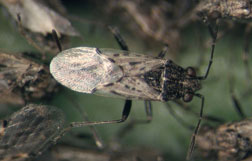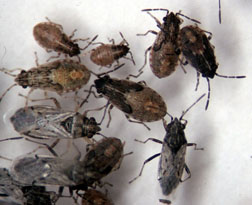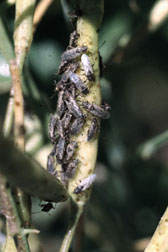by W. Cranshaw*
Quick Facts…
- Mustard family plants, such as radish, canola, and mustard greens are particularly favored by false chinch bugs.
- False chinch bugs feed by sucking sap from plants.
- False chinch bugs do not bite, do not feed nor damage anything indoors, and will ultimately die out if trapped inside.
- Chinch bugs are quite uncommon in Colorado. Spot infestations have been reported in some Denver area lawns and they are a bit more frequently found in home lawns in Tri-River counties of the West Slope.
False chinch bugs (Nysius raphanus) are small, grayish insects that sometimes become extremely abundant. They feed on a variety plants and occasionally cause some plant injury, particularly to certain highly favored mustards. During periods of extreme hot, dry weather they also may move to the relative cool of buildings and incidentally enter them.
Life History and Habits
 |
Figure 1. False chinch bug adult. |
False chinch bug spends the winter among winter annual mustards. Flixweed, a common weed associated with alfalfa fields and agricultural field margins, is an important winter host for this insect in eastern Colorado. When late winter/early spring temperatures warm sufficiently to allow development, eggs are laid around the base of plants. The nymphs that subsequently hatch are smaller than the adults, wingless, and more oval in form. Their general color is gray, and a red marking is often observable on the back. As the nymphs feed, molt and grow wing pads become increasingly noticeable. Multiple generations are produced during a single growing season.
False chinch bugs feed by sucking sap from plants. However, their feeding does not seem to be very destructive and often little, if any injury is observed. However, false chinch bugs most often occur in aggregations which sometimes can involve thousands of individuals on a single plant. Wilting and leaf dieback may occur under these conditions, particularly when plants are under drought stress.
 |
Figure 2. False chinch bug adults
|
Mustard family plants, such as radish, canola, and mustard greens, are particularly favored by false chinch bugs. However, they may feed on a very wide variety of plants including potato, kochia, lettuce, pigweed, quinoa and even turfgrasses. Largest masses of false chinch bugs are usually found on plants that are flowering or producing seed.
Control in Plantings
The need to control false chinch bugs in crops is rarely needed, particularly if plants are irrigated sufficiently to allow them to compensate for feeding injuries. Furthermore, problems are often sudden in onset—and may largely disappear suddenly when the adults disperse to new sites. Within agricultural crops problem areas are usually very spotty, with large aggregations present in only a small area of the field. If sprays are attempted best control is possible with some of the pyrethroids registered for the crop (e.g., esfenvalerate, lambda-cyhalothrin). Permethrin insecticides may also provide control, although false chinch bugs have been observed to recover within a few hours following an initial “knock-down” effect.
Control in Buildings
Mass migrations of false chinch bugs in the vicinity of buildings are primarily associated with very hot, dry weather. This may force the insects to move from drying weed hosts to seek shelter and higher humidity. Migrations indoors may occur through openings and cause nuisance problems. However, false chinch bugs do not bite, do not feed nor damage anything indoors, and will ultimately die out if trapped inside.
Irrigated landscapes adjacent to buildings may further encourage false chinch bug migrations to these areas. Therefore it may be desirable to temporarily discontinue watering in the immediate vicinity of the building when a problem migration is in progress. Providing cool, humid areas at some distance may encourage the insects to move away more rapidly.
Insecticides will have little, if any, effect for limiting this situation and are not recommended. False chinch bug migrations resulting in nuisance problems in buildings usually are of short duration and rarely last more than a week.
 |
 |
|
Figure 3. False chinch bug nymphs massed on flixweed seed pod. |
Figure 4. False chinch bug adults on seed pod. |
Chinch Bugs in Colorado
A related group of insects are the (“true”) chinch bugs, Blissus spp. Chinch bugs feed on grasses and several species are important as turfgrass pests in parts of the United States. In addition, the common chinch bug, Blissus leucopterus leucopterus, is a pest of small grains in the midwest. The chinch bug species recorded from turfgrass sites in Colorado is the hairy chinch bug, Blissus leucopterus hirtus.
Chinch bugs are quite uncommon in Colorado. Spot infestations have been reported in some Denver area lawns and they are a bit more frequently found in home lawns in Tri-River counties of the West Slope. Feeding injuries cause wilting and occasionally plant death. Chinch bug outbreaks are associated with hot, dry weather and irrigation largely suppresses these insects.
*W. Cranshaw Colorado State University Extension entomology specialist, and professor, bioagricultural sciences and pest management. 7/07. Revised 6/13.
Colorado State University, U.S. Department of Agriculture, and Colorado counties cooperating. CSU Extension programs are available to all without discrimination. No endorsement of products mentioned is intended nor is criticism implied of products not mentioned.
Go to top of this page.





